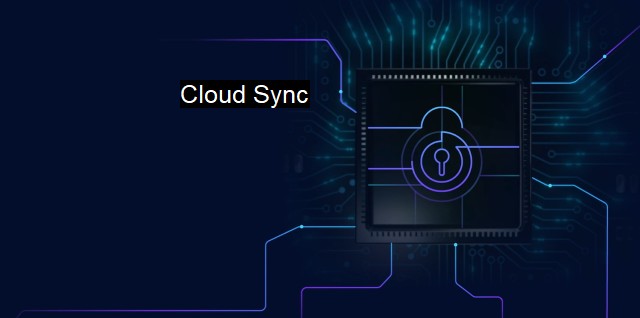What is Cloud Sync?
The Power of Cloud Syncing: Safeguarding Your Data with Cybersecurity and Antivirus Featuring Collaboration Across Remote Teams
Cloud sync is a prominent feature in modern software that allows for real-time updating and transferring of files across multiple devices connected to the internet. This adaption has not only become an expectation among consumers for convenience but also an integral part of business operations for seamless data access and collaboration.In the sphere of cybersecurity and antivirus, clear understanding of what cloud sync is and the strategies to leverage its benefits and mitigate potential security risks are crucial. We'll be delving deep into the utilization of cloud sync, alongside security concerns and ways to manage and counteract these risks.
Traditionally, data sharing and transfer necessitated physical storage devices. This resulted in higher costs, longer timescales for data management and lower operational efficiency. cloud sync has revolutionized these practices making it feasible to access data and files anytime, anywhere, with just an active internet connection.
Cloud sync employs storing a copy of the data in remote servers, which are maintained by reputable cloud service providers. To access the files, relevant users should get authenticated, post which, the requested data gets downloaded for use. Any alterations made are then synchronized across the stored versions.
Cloud sync is often mistaken for cloud backup. To clarify, cloud sync is maintaining consistency across multiple versions of the same data which might be updated from different devices. Conversely, cloud backup entails copy-pasting information from one location to another.
Cybersecurity and antivirus measures are integral to the functioning of cloud sync. The process stands exposed to cyber threats and the risk of data leakage or hijacking due to improper or barricaded security measures. Malware, for instance, can be innocuously uploaded onto the cloud and spread across the synced devices. Integrity of information can also get compromised due to unauthorized or illegal access as a result of cyber hacks or breaches.
Therefore, it is vital the information shared via the cloud gets promptly and regularly scanned for malware or viruses to circumvent corruption or loss of necessary data. Robust protective software and firewalls must be in place to safeguard against phishing, ransomware, spyware, etc.
Antivirus programs play pivotal roles in this scenario. High-quality antivirus applications conduct expedient detection, repair, and quarantine of potentially dangerous files or software. Most antivirus solutions provide a cloud-based functionality where detection of malware and threats serve as centralized information synced across all customer devices. This, in turn, alerts all users about prevailing threats and contributes toward quick repair, strengthening the cybersecurity setup.
Use of encryption is yet another measure to ensure data safety and integrity. Advanced encryption algorithms make the content unreadable to any unauthorized users, hence infusing an additional layer of protection. adopting multi-factor authentication processes can cavalier the security procedures further against possible breaches.
Cloud sync is a double-edged sword. Although it offers substantial benefits in terms of real-time accessibility, speed, and coordination, it does come with the added complexity of cybersecurity requirements. Moving ahead, intensive encryption, prompt antivirus scanning, robust cybersecurity measures should be prioritized alongside seamless synchronization to ensure data security.
Always choose a reputable cloud provider, adopting best security practices and powerful antivirus features. Cybersecurity should be constantly monitored, maintained, and updated in the ever-evolving landscape of the digital age, especially in applications leveraging cloud sync. This approach will secure data and applications against malicious malware, ransomware infecting synchronized data, eventually securing both network and users. Proper due diligence on our part integrated with the right set of technologies can turn cloud sync into an immense benefit and utility harnessing maximum gain while minimizing risk.

Cloud Sync FAQs
What is cloud sync?
Cloud sync refers to the process of storing and synchronizing data across multiple devices and cloud-based storage services. This allows users to access their files and data from anywhere, at any time using any device with an internet connection.Is cloud sync secure?
Cloud sync is generally secure as long as the cloud storage service implements security measures such as encryption, two-factor authentication, and access controls. However, users should take care to choose a reputable and secure cloud storage provider and regularly update their passwords and other security settings.Can cloud sync be used for cybersecurity and antivirus purposes?
Yes, cloud sync can be used as a cybersecurity and antivirus measure. By backing up important data and files to the cloud, users can protect their data against malware, ransomware, and other cyber threats. Additionally, cloud-based antivirus software can be used to automatically scan files and detect any potential threats.What are the benefits of using cloud sync?
The benefits of using cloud sync include increased accessibility, ease of collaboration, automatic backups, reduced storage costs, and improved disaster recovery. By ensuring that data is stored securely and redundantly in multiple locations, cloud sync can also provide an added layer of protection against data loss or theft.| | A | | | B | | | C | | | D | | | E | | | F | | | G | | | H | | | I | | | J | | | K | | | L | | | M | |
| | N | | | O | | | P | | | Q | | | R | | | S | | | T | | | U | | | V | | | W | | | X | | | Y | | | Z | |
| | 1 | | | 2 | | | 3 | | | 4 | | | 7 | | | 8 | | |||||||